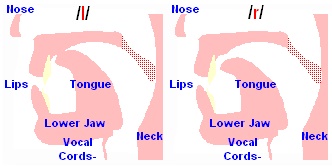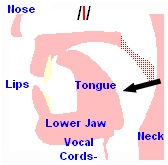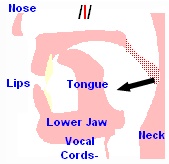Lesson 10
How to say it - /h/, /l/ & /r/ sounds
Introduction to /h/
/h/ is spelt 'h'.
To make the /h/ sound, use your lungs to push a lot of air out of your mouth very quickly. Do NOT touch the roof of your mouth with your tongue, but keep your tongue low. This is an unvoiced sound, but it is usually followed by a vowel which makes it voiced; eg. in 'Hello, how are you?'
This letter 'h' is often a silent letter, especially at the end of words; eg. in 'through' /θruː/.
Introduction to /l/ & /r/
/l/ is spelt 'l' and /r/ is spelt 'r'. The difference between these consonants is that in /l/ the tongue touches the roof of the mouth just behind the teeth, and in /r/ the tongue nearly but not quite touches the roof of the mouth.
To practise /l/ and /r/ move your tongue up and down and listen to the changing sound. This is a voiced sound. In both /l/ and /r/ the air goes around the sides of the tongue.

Introduction to /l/
/l/ is pronounced in two different ways, but the two sounds represent the same letter, so they use the same phonemic character /l/. Usually if the 'l' is at the front of the word; eg. in 'line', it is pronounced /l/. But if the 'l' is at the end of the word; eg. in 'beautiful', it is pronounced /l/. The difference is the shape of the tongue.
In /l/, when the 'l' is at the front of the word, the top of the tongue is curved out (convex).

In /l/, when the 'l' is at the end of the word, the top of the tongue is curved in (concave).

Don't worry too much about making these 2 different sounds. This is just for your information.
Introduction to /r/
To make this sound, turn up the front of your tongue, but don't touch the roof of your mouth. The sides of your tongue should touch your back top teeth. /r/ is written as the letter 'r'.
The letter 'r' is silent in a word if it is not followed by a vowel sound (ie. if it is followed by a consonant); eg. in 'earlier' /'ɜːliːə/.
Introduction to /l/, /r/ & /n/
/l/, /r/ & /n/ are quite similar. The difference between these consonants is that in /l/ the tongue touches the roof of the mouth just behind the teeth, and in /r/ the tongue nearly but not quite touches the roof of the mouth.
In /l/ and /r/ the air goes around the side of the tongue, but in /n/ the air is blocked by the tongue and exits through the nose.

Video of Mouth
Follow the instructions as they appear in the video.